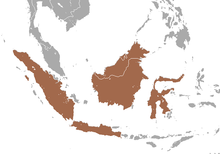
The little gull, is a small gull that breeds in northern Europe and across the Palearctic. The genus name Hydrocoloeus is from Ancient Greek hydro, "water", and koloios, a sort of web-footed bird. The specific minutus is Latin for "small".
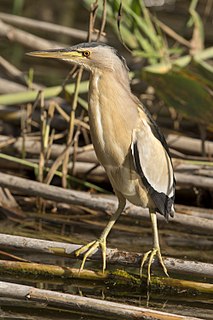
The little bittern or common little bittern is a wading bird in the heron family, Ardeidae. Ixobrychus is from Ancient Greek ixias, a reed-like plant and brukhomai, to bellow, and minutus is Latin for "small".

The Eurasian pygmy shrew, often known simply as the pygmy shrew, is a widespread shrew of the northern Palearctic.
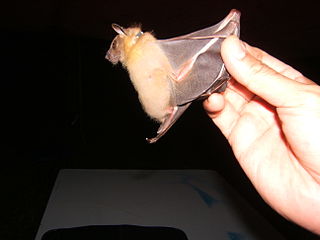
Cynopterus is a genus of megabats. The cynopterine section is represented by 11 genera, five of which occur in Malaysia, namely, Chironax, Balionycteris, Penthetor, Dyacopterus, and Cynopterus. About 30 names for Cynopterus species have been proposed, but only 16 are taxonomically valid forms.
Neacomys minutus, also known as the minute neacomys, the small bristly mouse, or the minute spiny mouse, is a rodent species from South America in the genus Neacomys. It is found in Brazil.

The little goblin bat is a species of bat in the family Molossidae, the free-tailed bats. It is endemic to Cuba.
Microryzomys minutus, also known as the montane colilargo or the forest small rice rat, is a species of rodent in the genus Microryzomys of family Cricetidae. It is found in Bolivia, Colombia, Ecuador, Peru, and Venezuela, but these populations may represent more than one species.

Blanford's fruit bat is a mountain species of megabat. It is found in several countries in South and Southeast Asia.
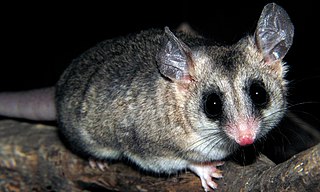
Thylamys is a genus of opossums in the family Didelphidae. The premaxillae are rounded rather than pointed. The females lack a pouch. The females' nipples are arranged in two symmetrical rows on the abdomen. All species but T. macrurus store fat in their tails., although this is not necessarily true for all species in the genus. Fossils belonging to the genus date back to the Miocene, with the oldest specimens being found in the Cerro Azul Formation of Argentina and the Honda Group of Colombia. Genetic studies indicate that the genus may have originated around 14 million years ago.

The greater short-nosed fruit bat, or short-nosed Indian fruit bat, is a species of megabat in the family Pteropodidae found in South and Southeast Asia.
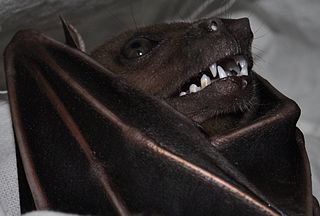
The Indonesian short-nosed fruit bat is a species of megabat in the family Pteropodidae. It is endemic to Indonesia, and has three subspecies:

The Angolan fruit bat, Angolan rousette or Silky bat is a species of megabat in the family Pteropodidae. It is found in Angola, Burundi, Cameroon, Central African Republic, Republic of Congo, Democratic Republic of Congo, Kenya, Nigeria, Rwanda, Sudan, Tanzania, Uganda, and Zambia. Its natural habitats are subtropical or tropical moist lowland forest, moist savanna, and rocky areas.

The lesser tube-nosed bat is a species of megabat in the family Pteropodidae. It is native to two of the Maluku Islands in northern Indonesia.

The Borneo fruit bat is a species of megabat found in the mountains of Borneo, specifically East Malaysia and Brunei. It is considered a subspecies of Aethalops alecto by some authors.
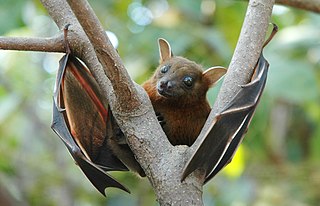
The lesser short-nosed fruit bat is a species of megabat within the family Pteropodidae. It is a small bat that lives in South Asia and Southeast Asia. It weighs between 21 and 32 grams, and measures 70 to 127 millimetres. It occurs in many types of habitat, but most frequently in disturbed forest, including lower montane forest and tropical lowland rain forest, plus gardens, mangroves, and vegetation on beaches.

Horsfield's fruit bat is a species of megabat native to South East Asia. It is named for Thomas Horsfield, an American naturalist who presented the type specimen to the British Museum.

Peters's fruit bat is a species of megabat within the family Pteropodidae. It is found in Sulawesi, Philippines, and adjacent small islands.

The Nusatenggara short-nosed fruit bat is a species of megabat within the family Pteropodidae found in Indonesia. It has three subspecies:
The Lami tuco-tuco is a species of rodent in the family Ctenomyidae. It is endemic to an area in the state of Rio Grande do Sul in southern Brazil, where it is found in the vicinity of sand dunes. The species is threatened by urbanization and the conversion of its habitat to agricultural use. Swamp drainage has led to a zone of hybridization with a neighboring population of C. minutus.

